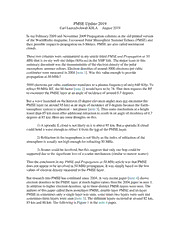
PMSE Update 2019 PDF
Preview PMSE Update 2019
PMSE Update 2019 Carl Luetzelschwab K9LA August 2019 In my February 2009 and November 2009 Propagation columns in the old printed version of the WorldRadio magazine, I reviewed Polar Mesosphere Summer Echoes (PMSE) and their possible impact to propagation on 6-Meters. PMSE are also called noctilucent clouds. These two columns were summarized in my article titled PMSE and Propagation at 50 MHz that is on my web site (https://k9la.us) in the VHF link. The major issue in this summary document was the measurements of the electron density of the polar mesosphere summer echoes. Electron densities of around 5000 electrons per cubic centimeter were measured in 2004 [note 1]. Was this value enough to provide propagation at 50 MHz? 5000 electrons per cubic centimeter translates to a plasma frequency of only 640 KHz. To refract 50 MHz RF, the M-factor [note 2] would have to be 78. That then requires the RF to encounter the PMSE layer at an angle of incidence of around 0.7 degrees. But a wave launched on the horizon (0 degree elevation angle) does not encounter the PMSE layer (at around 85 km) at an angle of incidence of 0 degrees because the Earth- ionosphere system is spherical – not planar [note 3]. Thus some mechanism at a height lower than 85 km must offer additional refraction to result in an angle of incidence of 0.7 degrees at 85 km. Here are some thoughts on this. 1) A sporadic E cloud is not likely as it is above 85 km. But a sporadic E cloud could bend a wave enough to refract it from the top of the PMSE layer. 2) Refraction in the troposphere is not likely as the index of refraction of the atmosphere is usually not high enough for refracting 50 MHz. 3) Scatter could be involved, but this suggests that only one hop could be supported due to the significant loss of a scatter mechanism (similar to meteor scatter). Thus the conclusion in my PMSE and Propagation at 50 MHz article was that PMSE does not appear to be involved in 50 MHz propagation. It was simply based on the low values of electron density measured in the PMSE layer. But research into PMSE has continued since 2004. A very recent paper [note 4] shows electron densities in the PMSE layer at much higher values than the 2004 paper in note 1. In addition to higher electron densities, up to three distinct PMSE layers were seen. The authors of this paper called them monolayer PMSE, double-layer PMSE and tri-layer PMSE as sometimes only a single layer was seen, some times two layers were seen and sometimes three layers were seen [note 5]. The different layers occurred at around 82 km, 85 km and 88 km. The following is Figure 1 in the note 4 paper. With maximum electron densities around 1012 electrons per cubic meter, the plasma frequency would be 9 MHz. Thus an M-factor of only 5.5 is needed to refract low elevation angle 50 MHz RF, which is a typical M-factor value for low elevation angles with electron densities at 85 km. Thus recent data suggests that PMSE can be a valid propagation mode on 50 MHz. Maybe not all PMSE conditions, but the paper of note 4 shows there are conditions in which 50 MHz may be supported. But there is one issue that remains in my mind. PMSE layers, just like sporadic E layers, are thin – in other words, their vertical extent is limited to several km. Is there enough vertical extent of the ionization for refraction (bending) to occur? This concern comes out of the fact that the amount of refraction incurred by a wave is inversely proportional to the square of the frequency. Thus a higher frequency wave will not be bent as much as a lower frequency wave, and thus the higher frequency wave needs more vertical extent in ionization to turn it back to Earth. Is several km enough to turn around 50 MHz RF? From a very cursory look at refraction at 50 MHz with ray tracing in Proplab Pro V3, it doesn’t look like the vertical extent of a single PMSE layer is enough to refract 50 MHz. But as noted on page 1, it could be that a lower PMSE layer provides enough refraction to reduce the angle of incidence on the ionosphere due to a second higher PMSE layer. Alternately, there may be some scatter involved – some additional loss traded for the fact that the MUF is a bit below the operating frequency (an above-the-MUF mode). That’s about as far as I can go with this – unless more data shows up. Notes 1) Rapp and Lubken; Polar mesosphere summer echoes (PMSE); Atmospheric Chemistry and Physics; 4, 2601-2633, 2004. 2) The MUF (maximum useable frequency) at any given time over any given path is equal to the critical frequency (usually for either the E region or the F2 region) times the M-factor. The M-factor is dependent on the angle of incidence of the wave on the ionosphere through the secant law in a spherical Earth-ionosphere system. 3) The angle of incidence on the ionosphere at 85 km for an elevation angle of 0 degrees is 9.31 degrees. The M-factor would be 6.18 – a far cry from 78. 4) Ge, Li, Xu, Zhu, Wang, Meng, Ullah and Rauf; Characteristics of the layered polar mesospheric summer echoes occurrence ratio observed by EISCAT VHF 224 MHz radar; Annales Geophysicae; 37, 417-427, 2019. 5) The tri-layer data in Figure 1c is similar to bite-outs in the D region of the ionosphere. These characteristics are not unexpected, as there are very complicated chemical processes occurring down in the lower ionosphere.
